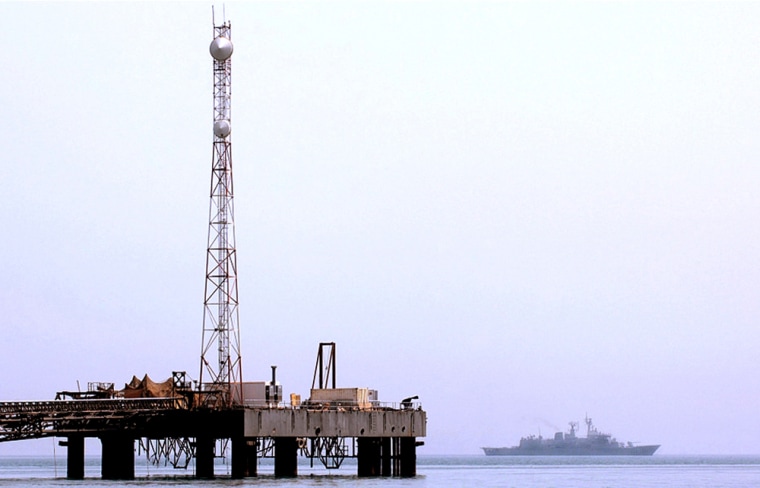Stronger moorings for production platforms. Deeper pipelines. Larger supplies of backup electricity, water and other supplies.
The petroleum industry has spent vast amounts of time and money since the catastrophic hurricanes of 2005 trying to make sure it’s better prepared for the next big blow.
That could come in the next few days as Hurricane Gustav heads into the northern Gulf of Mexico, home to a complex web of platforms, pipelines and refineries in a region that produces roughly 25 percent of the nation’s oil and 15 percent of its natural gas.
Retail gas prices swung higher Friday for the first time in 43 days as analysts warned that a direct hit by Gustav could send pump prices hurtling toward $5 a gallon
Three years ago, as they prepared to fix the Gulf’s devastated oil and gas facilities, industry representatives realized standard repairs weren’t enough. So the companies that own the platforms, drill the wells and manage the pipelines spent hundreds of millions of dollars to improve and strengthen their operations.
Still, as Gustav churns, a question lingers: How will the revamped structures, pipelines and other equipment hold up to a major hurricane?
“I think the industry is smarter, but it’s hard to say if it’s better prepared,” said David Purcell, an analyst at Tudor Pickering Holt & Co. Securities. “If you think about an old car and you repair it, it’s hard to make it better than new. But you can make it close to new. The question is: Is new good enough?”
Petroleum companies certainly learned some hard — and very expensive — lessons from hurricanes Katrina and Rita, the culprits of the 2005 devastation. Those storms destroyed 115 of the Gulf’s 4,000 oil and gas platforms and damaged 52 others.
Even Royal Dutch Shell’s enormous Mars production platform could not withstand the forces unleashed by Katrina. The storm’s 175-mph winds and 75-foot waves broke steel clamps that held the 1,500-ton rig structure to the platform and knocked a 200-foot derrick into the water. The surge caused the rig to rise up and slam into the platform, causing heavy damage.
U.S. pump prices surged from slightly more than $2 a gallon to above $3 after Katrina and Hurricane Rita swept through the Gulf in 2005.
“The price consequences could be even worse this time,” said Jeff Rubin, chief economist at investment bank CIBC World Markets, in a report, noting that inventories are even lower this time. “Any replays of the 2005 storm season could see gasoline prices soar to $5 per gallon.”
But the industry has worked hard to brace itself. Clamps on the Mars production platform are four times stronger, according to Shell, for example.
“If one major deep-water production platform is destroyed, you’re talking about a $1 billion or more loss,” said Satish Nagarajaiah, a civil and mechanical engineering professor at Rice University. “If it’s multiple rigs and platforms in a variety of water depths, then we’re talking billions of dollars.”
Soon after the 2005 storms, Shell joined a number of industry players — other oil companies, federal agencies, the American Petroleum Institute, among them — looking at ways to better protect themselves against such disasters and minimize the damage and subsequent supply disruptions that contribute to spiking energy prices.
One of the key conclusions was the need for stronger mooring systems that anchor rigs to the sea floor, sometimes in thousands of feet of water. That’s prompted major rig owners like Transocean Inc. and Noble Drilling Inc. to increase the number of anchor lines.
Noble spent as much as $30 million apiece to strengthen moorings on five deep-water rigs. The company also has added new monitors to rigs that will allow it to track, via the Internet, wind speed, wave heights and pitch and roll during a storm.
Giant rigs unhinged by Katrina and Rita dragged mooring lines and anchors, raking the sea floor and damaging pipelines. Natural gas provider El Paso Corp. has since buried some offshore pipelines deeper and added breakaway joints that automatically shut off the flow of gas if the line is broken.
On the refining side, the two biggest challenges after the 2005 storms were power disruptions and flooding — both of which prompted refiners to examine their practices and make adjustments. Altogether, the Gulf Coast is home to nearly half the nation’s refining capacity.
Since the 2005 punch, many refineries have raised critical equipment so it won’t flood and beefed up plans to get backup power as quickly as possible.
Companies also learned that it is impossible to run operations offshore if you can’t find and take care of your people onshore. The 2005 hurricanes shattered communications and scattered people for hundreds of miles.
Shell now says it has the capacity to quickly build base camps — complete with lodging, showers and kitchens — to sustain hundreds of refinery and pipeline workers about eight hours after a storm passes. The facilities would be hauled in by 18-wheelers and erected at prearranged sites.
“There was that brief period after Katrina came ashore where there was no electricity anywhere,” said Sara Banaszak, senior economist at the American Petroleum Institute, a trade group. “Pipelines couldn’t operate. Nothing was happening. A lot of change has occurred in how we prepare for these severe storms.”
